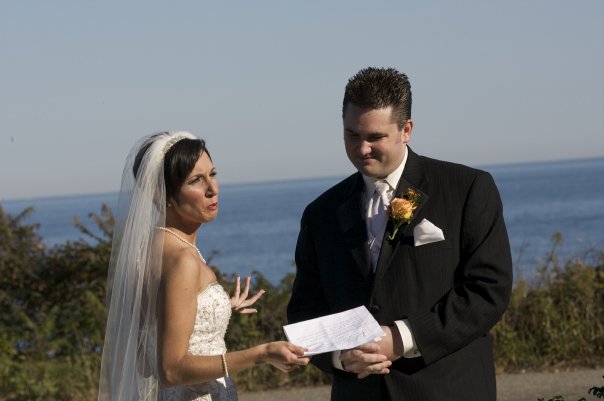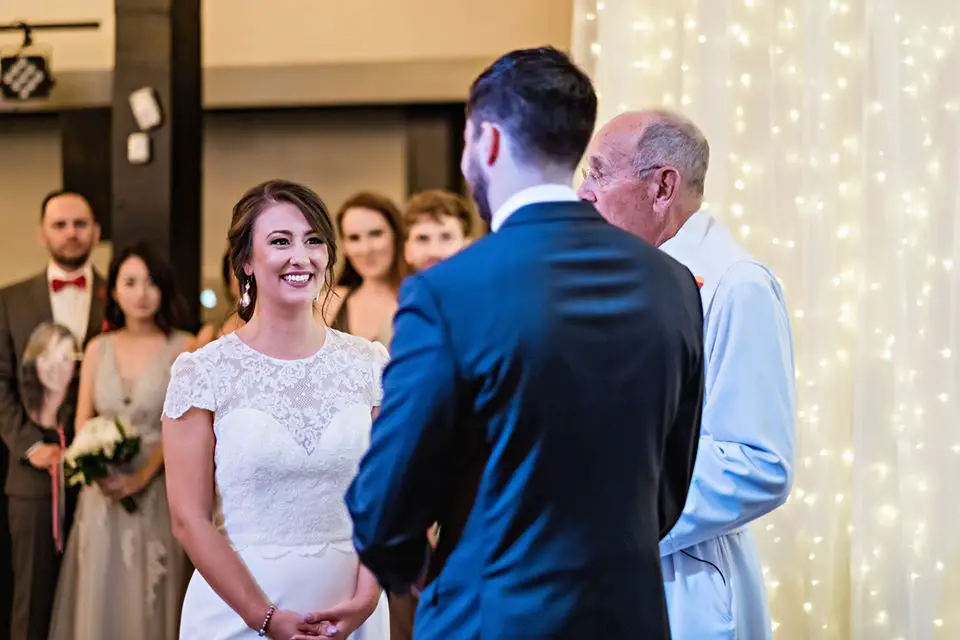Planning a wedding and writing your own ceremony script? Me too! And I’m here to help you make the process easier and share all that I’ve learned from many authors, professional officiants, and personal experience of being a bridesmaid at many weddings!
This post includes the 10 steps to follow to write your perfect wedding ceremony script, as well as the ceremony basics that are essential to accomplish before you start writing your script.
I’ve also included some full sample wedding scripts below in PDF form if you want to use them as a template and adjust them to your personal preferences:
Sample Wedding Script for a Simple Ceremony
Sample Wedding Script for a Handfasting Ceremony (which comes with a 10-Step Guide)
I also made a video on this topic for those who prefer audio-visual 🙂 I’ll drop it down below and be sure to check out my wedding YouTube channel for plenty of tips and ideas for your wedding:
Basics to Follow Before Writing Your Wedding Ceremony Script

This post is for couples who want to design their own wedding ceremony scripts. If you’re planning on having a traditional religious ceremony, there is most likely a ready-made script to follow, and you’ll have a few customization options that you can talk through with the head of your church, temple, etc.
For the rest of us, we’re choosing everything ourselves, from the processional music to the readings to the exact wording of the vows.
But before even sitting down with your partner to start writing the official wedding ceremony script, you have to really, truly think about and make decisions about a few things. If you don’t cover the following items together first, writing the ceremony will be a lot more difficult for you later on!
1. Stick to your guns
Wedding ceremonies can be contentious and suddenly many people close to you may have strong opinions about what you should do. What I mean by “stick to your guns” is to get on the same page as your partner from the start… decide what is important to the two of you in terms of customs, traditions, religion, etc. and who you want involved in your ceremony. Look each other in the eyes and promise to have each other’s back no matter which stubborn family member tries to step in and get their way.
2. Choose the ceremony layout
The feel of your ceremony will be HEAVILY affected by the layout of the space where your wedding is taking place. Many people don’t realize just how important this element is. If you want your ceremony to feel intimate, but people are in a giant room, it’s not going to work out quite how you envision it. You should write your ceremony script with the layout of the ceremony in mind. Which leads me to…
3. Where will your guests sit?
Let your guests sit down and be comfortable during the ceremony. If you are planning on having your guests stand during the ceremony, don’t make the ceremony ANY longer than 15 minutes or it’s going to get ugly. If your guests are comfortable (and maybe even have a drink in hand?), they’ll enjoy your ceremony much more.
4. How long do you want the ceremony to be?
A wedding ceremony should be between 15-45 minutes long, with a 25-30 minute ceremony being the ideal length. People want to enjoy the ceremony but they also want to get the party started, so don’t torture them by holding them hostage.
5. How many people and who do you want involved in the ceremony?
Do you want to use your ceremony as a way to involve certain family members and friends in your wedding? Think about using roles like ‘reader’ to accomplish this. Also consider adding a ritual such as a wishing stone ritual to involve the crowd more. In a wishing stone ritual, everyone gets a small stone to either “put a wish into” or literally write a wish on for the couple at some point in the ceremony.
6. Will it be religious at all?
You have to decide earlier on if you want your ceremony to include religious elements or not. If you don’t decide, your family members may make the decision for you and you may feel too bad to say anything about it. I have friends who were unsure and ended up with a much more religious ceremony than they wanted because they weren’t clear with their families from the beginning.
7. Where will the props go, and who’s in charge of them?
If you’re doing something like a unity candle ceremony, a handfasting ceremony (or even for a simple ring exchange), there will be “props” involved. Assign someone to be in charge of them, such as the best man, the officiant, or a combination of people.
8. Choose your officiant
Choose your officiant and book them well in advance. Keep them in loop during this whole script-writing process. Be very honest about what you want and what you’re trying to accomplish in terms of what ceremony elements you want to include, and the vibe you’re going for.
9. Use microphones!
When people can’t hear what’s going on, it’s THE WORST. Get a microphone and teach everyone how to use it at the rehearsal. Make sure everyone knows that they need to hold it close to their mouths for it to work!
10. Get a mic stand for your officiant
Your poor officiant will have a lot to juggle between the script, props, and running the show. Make sure there’s a mic stand there to make things easier, or it can get awkward.
Okay NOW it’s time to get down to business and write that ceremony script… 🙂
How to Write the Perfect Wedding Ceremony Script in 10 Steps
Jeltie Gordon-Lennox, author of Crafting Meaningful Wedding Rituals: A Practical Guide, wrote that “A custom wedding ceremony is, by definition, one of a kind. It has never been done before and will never be done again.”
She suggests in her book allotting 6 to 12 months for creating your wedding ceremony! As I read this book, I began to see how important it is to really put thought into our ceremonies, and to not leave them to the last minute, or as an afterthought to the photography or cake.
Our guests are coming from far and wide to be part of this experience. They want to see and be involved in a true romantic moment… to be transported, to be moved. And to accomplish such a dramatic feat will take some time, thought, and effort on our part.
Let’s do it: Follow these 10 steps to write your own unique wedding ceremony! 🙂
Step #1: Create a Google doc and share it with your partner
Pick a free afternoon when you both have a couple of hours to sit together on the couch and work on this project in peace. Make yourselves a couple of cups of coffee, put on some music and enjoy the process.
The first thing to do is create a Google doc and share it with your partner, so that you both have access to it and can tweak it and work on it together at the same time. You’ll both also feel complete ownership and not like one partner is calling all the shots as editor-in-chief of the document. It’s important for both of you to be involved and open to each other’s suggestions.
I was surprised when I started discussing my own wedding ceremony with my partner for the first time that he felt strongly about the readings. He didn’t want us to assign readings to our friends and family members, but to instead allow them to choose and make it a surprise for us! I had already picked out, planned for, and imagined certain readings and felt blindsided by his opinion (my own fault!).
I had no idea that this was something we needed to discuss because I’d just made the assumption that he wouldn’t have a strong opinion on the matter. Learn from us and don’t assume anything. Discuss every detail of the ceremony with your partner.
Step #2: Brainstorm all of the elements you want in your ceremony
Before creating a structure of any kind, just go crazy typing out a long list of everything you want, or might want, to include in your wedding ceremony. You should both do this at the same time in the Google doc — or on a piece of paper if you prefer.
Don’t limit yourselves at all. Just write whatever image, ritual, poem, or a thing that you want your mom or dad to do for example… write it all in a messy brainstorming list. It helps to close your eyes and picture yourself on the day of your wedding. What do you want to feel? What rituals do you see yourself and your partner participating in? Get it all on paper.
Your brainstorming list might look something like (or nothing like!) this example:
- walk down the aisle with dad
- say our own vows
- unity candles
- use a Dr. Seuss poem
- the story of how we met somewhere
- sand mixing ritual
- would like my grandmother who has passed to be acknowledged
- my little brother says a reading
- the song ‘Over the Rainbow’ in the processional
- etc…
Step #3: Make a rough outline of your ceremony script
In this next step, you’ll take that messy brainstorming session and start to whittle it down to a solid ceremony outline.
Go through each of the items on both of your brainstorming lists and talk about them. By discussing each one out loud, you’ll come to see why some are important to you and which ones, if any, are not so essential. Ask each other:
- Why is this element important to you?
- How do you imagine this part of the ceremony playing out?
Put a little check mark or something next to the essential elements that you must have in your ceremony.
Now we’re going to start to give your ideas some structure. In the same Google doc (I would start at the top of the doc and push your brainstorming session to the bottom to later be written over/deleted), start writing a skeletal ceremony outline. Don’t worry about writing any large chucks of text just yet.
Remember that there are no rules for what you have to include, and it’s YOUR ceremony to tweak. But here is a basic outline that you can work with to help guide you:
- Processional song for the wedding party:___________________________________
- Processional song for the bride’s entrance:_________________________________
- Welcome Remarks/Opening prayer
- Reading #1
- Reading #2
- Ritual: Celebration of the Hands
- Marriage Address
- Vow Exchange
- Ring exchange
- Declaration of Marriage
- Signing of legal paperwork
- Recessional song:_____________________________________________
Once you’re satisfied with your outline, you can move onto the next step!
Step #4: Choose the processional and recessional music
It’s no mystery that music has the power to put us in a particular mood. What mood do you want to create right from the start at your ceremony?
You can choose one song for all of your wedding party to walk in on as well as the bride. Or you might want the bride to have a song of her own. You might have a totally non-traditional wedding procession, such as the couple walking in together or no wedding party at all. Whatever the situation, it’s nice to start the ceremony off with a mood-setting tune.
This is a personal choice that should be discussed between the two of you and you may find that it’s a really difficult choice! My suggestion is to just go with your gut. Then play the song with your eyes closed and see if you can imagine yourselves on the day with THIS song playing.
Here are just a few ideas for your processional songs that you might like to choose from:
- A string quartet version of any song you love
- A modern processional song from this Wedding Wire list
Make a note of your song choices in your outline. If you can’t decide on one right now, may a little list of your top choices.
For the recessional song, I would recommend choosing something upbeat and fun. You’ve just been announced as a married couple for the first time! Let everyone celebrate with you with a happy, dance-y song to get everyone in the mood to party at the reception!
Step #5: Choose your readings
A “normal” amount of readings for your wedding is 2-3 of less than 5 minutes each. Any more than this and it can get to be a bit too much. Readings can be a special addition to your ceremony, but only if you pick a reading that’s actually meaningful to you.
What you don’t want to do is just pick a reading because it’s what you “should do.” Don’t pick a random reading that someone suggested. Instead, do some research and find a reading that’s actually special to you– a poem, piece of writing, prayer, song lyrics, etc. that you or your partner love.
I’ve compiled quite a few lists of wedding readings if you need help choosing:
- 25 Romantic Wedding Readings from Movies and TV
- 30 Wedding Readings from Song Lyrics
- 30 Traditional Wedding Readings For Your Big Day
- 25 Nerdy Wedding Readings for Unique Ceremonies
- 30 Adventure Wedding Readings for the Wanderlust Couple
- Wedding Readings from Harry Potter
Step #6: Create the welcome and opening remarks (and prayer if you want one)
You’ll most likely want your officiant will start off your wedding ceremony with words of welcome and an opening statement. It’s really important to get your ceremony off on the right foot, to set the tone of your event right from the start!
If you want a lighthearted, relaxed event, your officiant can immediately and jokingly put everyone at ease and prepare your crowd for a fun ceremony. If you’d prefer that it’s a bit more traditionally somber or serious in tone, your officiant can accomplish that with the opening words as well!
On your Google doc, start typing out some opening words for your officiant to say. It’s a good idea to include the following, in your own words:
- Say hello and welcome, and thank you for coming…
- Say something along the lines of “We’re all here to celebrate the marriage between Mary and Joe…”
- Tell a personal story about the couple
I think the personal story is a wonderful way to make the wedding meaningful right from the start — not to mention super romantic. Your officiant could tell the story of how you met and ended up here today, or any sweet story from your lives as a couple. Everyone loves a story and it’s the stories that are remembered best after a wedding.
Here is a sample welcome and opening statement:
“We are gathered here today in the presence of loved ones to celebrate the marriage of Jim and Alice, in this beautiful place. We welcome you all. A wedding is such a wonderful occasion, filled with hopes, dreams, and excitement. We are here today to recognize and witness the decision of Jim and Alice to move forward in their lives as married partners.
If you ask most couples who have a strong and abiding love, what they like most about their partners, they’ll usually say that they don’t have to pretend to be anything other than who they are. They are able to express themselves without fear of being judged or rejected. There is room in the relationship for both of them to be individuals. They are free to surrender to the possibility of profound intimacy, to be known and loved without condition.
The story of how Jim and Alice met goes like this…”
A couple of things to note:
- Talk to your officiant beforehand and ask them what they would feel most comfortable with. Some officiants like to be given a word-for-word script to follow; while others prefer bullet points (and they use their own words). Also, decide which you feel most comfortable with.
- If you’re religious at all, it’s a good idea to include an opening prayer in your opening remarks. Find an officiant who is comfortable with this.
Step #7: Add a “Marriage Address”
I repeat: Not of these elements are absolutely necessary. You can pick and choose as you desire. However, it’s nice at some point during your ceremony to have the officiant give a brief “marriage address” which is sort of a definition of marriage, or “hopes for a healthy marriage.” It can be from a poem or literary excerpt, or a religious text.
Whatever text you choose, make sure it’s reflective of you and your true beliefs as a couple or it will miss the mark, and not be as meaningful.
Here’s a sample:
“Marriage is the essence of human relationships. It challenges us to be of one accord without abandoning the truth of our individuality. It challenges us to not lose ourselves in one another, but rather to walk side by side heading in the same direction.
As with all relationships, marriage is an endless presentation of choices about how we want to be with another. Each choice results in either more unity or more separation. Choose unity, John and Mary, every chance you get.
Sacrifice your judgments, expectations, and any other ways that you have learned to separate yourselves from each other.
Share the gifts of your friendship, humor, vulnerability, sensitivity, and kindness. Be sure to find ways each day to protect, affirm, and support each other, and to treasure the balance and shared values that you have found with each other.
Enjoy the intertwining of your independence with your intimacy. I wish you the courage to keep your loving hearts open to each other for the rest of your lives.”
Step #8: Decide which kind of vows you want to exchange and the language for your ring exchange
Your vows are a public promise to love, honor, and respect each other and to keep the marriage healthy. There are essentially three ways of doing wedding vows:
- A repeat-after-me style vow wherein the couple repeats each line after the officiant,
- The officiant says the vows and the couple responds simply “I do” afterward, or
- The couple writes and says their own vows.
A repeat-after-me or simply saying “I do” situation is good is you don’t like public speaking or you’re afraid of not being able to express yourselves well in such a highly emotional setting.
However, writing your own vows can be extremely powerful and moving. If you do decide to write your own vows, I recommend following these guidelines:
- Decide before you each start writing what the word count should be (300 words is usually a good marker) so that you don’t have super lopsided vows in terms of time.
- Don’t wait until the last minute. Each of you should write your vows, or start writing them, a good month or more in advance. Don’t put more advance work into picking out flowers or a dress than you do into your vows!
- Practice, practice, practice. Practice saying them out loud, in front of a mirror, in front of other people, as many times as possible, You don’t know what the emotionally heightened atmosphere of a wedding can do to a person. Practice so that saying your vows is as natural for you as possible, and so you’re not glued to your notes, but can look into the eyes of your partner for at least part of what you’re saying!
- Plan out where the vows will be written and who will carry them. This should probably be a document, printed on big size 14-ish font (you don’t want to be squinting at your notes) and given to your officiant to hold for safe keeping. This way, your officiant can simply hand you the clean sheet of paper right before you say the vows. A crumpled up piece of paper or a folded ugly paper from your pocket is not the best look.
- Write your vows in verse like a poem. If you do this instead of writing in prose, you’ll allow for more “air” between your thoughts, and will be more likely to pause more often and take your time. People want to hear what you have to say, so don’t rush through your vows.
- Breathe and enjoy the moment. Take your time and don’t be afraid to let out any emotions that come out!
If you want your vows to be a surprise to each other, obviously don’t write them into the shared Google doc. Send your final versions of your vows to your officiant via email separately the week before the wedding.
For your ring exchange, you can write something for your officiant to say or use some simple language such as this example:
“These rings are symbols of the love that joins you spirit to spirit. They represent the oneness, eternity, and renewal inherent in the marriage union. May these rings serve you and those who see them upon your fingers as reminders of the vows you have made here today and of our need to be faithful in all our relationships.”
Step #9: Include any other important family or cultural rituals
This is a fun part to consider including in your ceremony that could personalize your wedding a lot. Are there any family or cultural elements that you’d like to include? A handfasting ceremony for instance? I wrote an entire 10-part guide on how to do a handfasting ceremony at your wedding if this kind of Celtic ceremony is interesting to you.
You might also consider something like a sand-combining ceremony, a wishing stone ceremony, a tree planting ceremony, or a unity candle ceremony which are all popular options.
These rituals are often something visually appealing or interactive for your guests, and make the whole event even more memorable. I suggest talking at length with your officiant about the ritual you want to include to make sure they’re comfortable with it. If not, consider asking another person to step in, just to run this part of the ceremony.
Write the words into your script that you want the officiant to say. Here is an example of words that could be said in a unity candle ceremony in which there are two candles, each representing one member of the couple, and a third candle, or unity candle, representing their new life together…
Officiant:
“Every human being possesses a special light that burns within them. When two spirits, destined to be together, find each other, their streams of light flow together, and a single, brighter light goes forth from their union.
________ and ________, by committing to one another today, you kindle the light within each other, and promise to do your best to always see that light within one another, to nurture and tend that flame in your partner as best you can, especially in difficult times, when this may be hardest to do.
_________, take this candle as a symbol of your spirit: and _________, take this candle as a symbol of your spirit. Now joining your individual flames together, light the center candle which symbolizes the spirit of your union and the new and greater flame of your marriage.
As you do so, silently vow to tend to the spirit of this union, and never forget that just as this union is made stronger by your strength as individuals, so are you as individuals made stronger by the strength of this union.”
Step #10: Read through it word-for-word and time yourselves
At this point, if you’ve followed the previous 9 steps, you should have a solid wedding ceremony outline that has started to gain quite a bit of “meat” with the songs, readings, marriage address, unique ritual, and notes about your vows typed into the document!
You can add some closing remarks for your officiant to say, and a declaration of marriage (“I now pronounce ______ and _______ married! You may kiss!”).
Now it’s time to practice! Together, set a timer and read through the entire script slowly. Add time for the processional (about 3 minutes) and the vows (about 5 minutes). Ideally, your ceremony should never be longer than 45 minutes.
In fact, at 45 minutes, you’re really pushing it for many people who will want to go to the bathroom, deal with a whiny child, or simply have a drink and get the party started! Don’t hold your guests hostage in an attempt to do every single wedding ritual imaginable. If it’s running too long, consider cutting a reading or shortening some of the remarks throughout.
During and After Writing Your Wedding Ceremony Script
Communicate with your officiant
Let your officiant in an everything during the process and communicate with them a lot in the week or two before the wedding to make absolutely sure you’re on the same page. Check to make sure they have the final version of your ceremony in the days before the wedding, and that they are available for a rehearsal. Don’t assume anything! Always ask and make sure.
Decide on and assign roles to family and friends
Once you’ve decided on the readings and other details for your ceremony, reach out to friends and family members personally who you want to participate and ask them. Most people will be delighted to be asked for such an honor, but be prepared that for some people, the thought of public speaking is terrifying. And assure them that they can refuse if they want!
Organize a rehearsal
It doesn’t have to be a rehearsal followed by a fancy dinner, but you should definitely have a rehearsal of some kind before the actual wedding. It will make everyone involved, including you, much more relaxed if you’ve run through it. Make it quick, run through it twice, and have someone who isn’t you be in charge! People can be surprisingly hard to wrangle at these things and you don’t want to have to be the one asking everyone to pay attention!
Continue to stick to your guns!
Everyone is going to have soooo many opinions throughout this process, which is why that meeting with your significant other on the couch that afternoon, having a heart-to-heart about what each of you reeeallly wants, is so important. Stay strong and politely inform family and friends that you’ll be doing the ceremony your way 🙂
Sources:
Crafting Meaningful Wedding Rituals: A Practical Guide by Jeltie Gordon-Lennox
The Wedding Ceremony Planner:The Essential Guide to the Most Important Part of Your Wedding Day by Reverend Judith Johnson, Ph.D.




